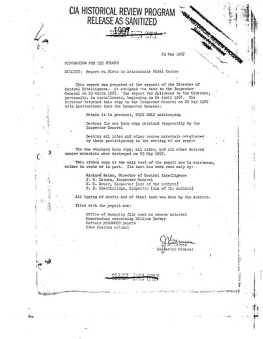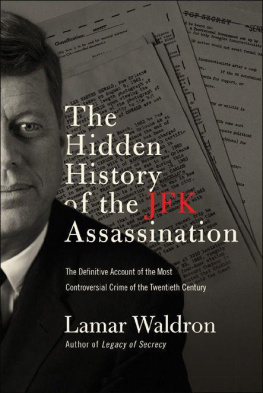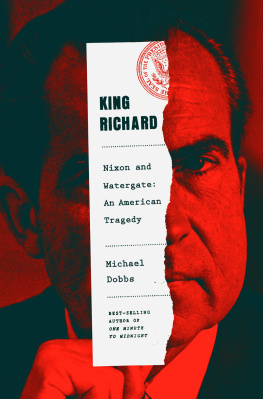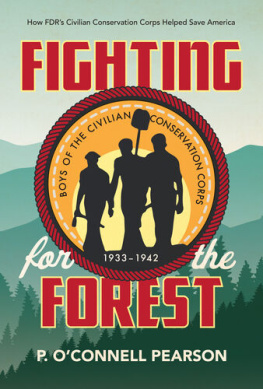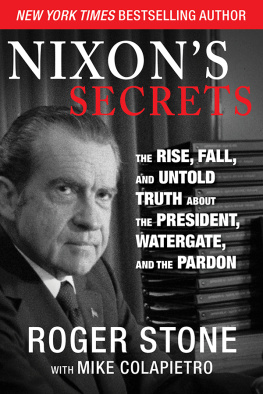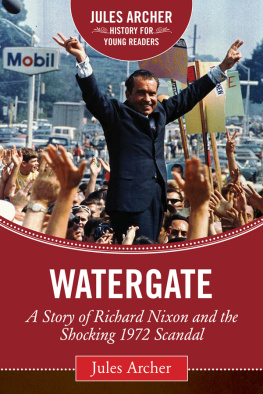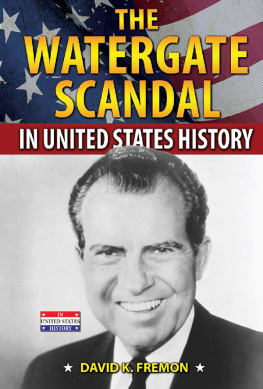
Scribe Publications
WATERGATE: THE HIDDEN HISTORY
Lamar Waldrons historical research and nonfiction books have won praise from Publishers Weekly , Vanity Fair , newspapers ranging from The Boston Globe to the San Francisco Chronicle , and major publications in Europe. His groundbreaking research has been the subject of two prime-time specials broadcast on the Discovery Channel and produced by NBC News. He has been featured on CNN, the History Channel, and television specials in England, Germany, and Japan. Called the ultimate JFK historian by Variety , Waldron is the author of Legacy of Secrecy: the long shadow of the JFK assassination (also published by Scribe), which is being produced as a major motion picture by Leonardo DiCaprio, for Warner Brothers.
Scribe Publications Pty Ltd
1820 Edward St, Brunswick, Victoria, Australia 3056
Email: info@scribepub.com.au
First published in the United States by Counterpoint, 1919 Fifth Street, Berkeley, CA 94710
Published in Australia and New Zealand by Scribe 2012
Copyright Lamar Waldron 2012
All rights reserved. Without limiting the rights under copyright reserved above, no part of this publication may be reproduced, stored in or introduced into a retrieval system, or transmitted, in any form or by any means (electronic, mechanical, photocopying, recording or otherwise) without the prior written permission of the publishers of this book.
National Library of Australia
Cataloguing-in-Publication data
Waldron, Lamar, 1954-
Watergate: the hidden history: Nixon, the Mafia, and the CIA.
9781921942662 (e-book.)
Includes bibliographical references.
1. Nixon, Richard M. (Richard Milhous), 1913-1994. 2. United States. Central Intelligence Agency. 3. Watergate Affair, 1972-1974. 4. Intelligence serviceUnited States. 5. MafiaUnited States.
973.924
www.scribepublications.com.au
This book is dedicated to the following authors, journalists, and investigators. In the 1970s, they uncovered crucial evidence about Watergate and related mattersand decades later, theyre still waiting for some of the most important files to be declassified.
William Turner
Anthony Summers
Peter Dale Scott
Dick Russell
Peter Noyes
Dan Moldea
Gaeton Fonzi
Contents
PART I
Chapter 1
Chapter 2
Chapter 3
Chapter 4
Chapter 5
Chapter 6
Chapter 7
Chapter 8
PART II
Chapter 9
Chapter 10
Chapter 11
Chapter 12
Chapter 13
Chapter 14
Chapter 15
Chapter 16
Chapter 17
Chapter 18
PART III
Chapter 19
Chapter 20
Chapter 21
Chapter 22
Chapter 23
Chapter 24
Chapter 25
Chapter 26
Chapter 27
Chapter 28
Chapter 29
Chapter 30
Chapter 31
Chapter 32
Chapter 33
Chapter 34
Epilogue
PART I
CHAPTER 1
I ordered that they use any means necessary, including illegal means...
President Richard Nixon to Chief of Staff Alexander Haig, 5-23-73
Almost forty years after the Watergate arrests on June 17, 1972, three myths about it are still pervasive. First, that the scandal only concerned a third-rate burglary of the headquarters of the Democratic National Committee (DNC), at the Watergate complex in Washington, D.C. Second, that the cover-up was worse than the crime. And finally, that two reportersBob Woodward and Carl Bernstein of The Washington Post brought down President Richard M. Nixon.
Not one of these is true.
The three myths of Watergate have been demonstrably false for decades. President Nixon had his spokesman minimize the scandals importance by calling it a third-rate burglary, and Nixon was initially successful: Watergate was not a factor inor even widely reported duringthe fall 1972 Presidential campaign between President Nixon and Democratic candidate George McGovern. Richard Nixon was reelected in a landslide.
Whats wrong with the third-rate burglary claim? To begin with, even the singular term burglary is misleading, since Congressional and Justice Department investigations showed that four burglaries were actually attempted at the Watergate. Additionally, in the weeks before the final Watergate break-in, Nixons Watergate operatives committed several other burglaries. Their targets ranged from Democratic offices (including those of McGovern, Gary Hart, and Sargent Shriver) to journalists to the Chilean embassy in Washington.
Was the the cover-up worse than the crime? Nothats another completely inaccurate myth, since Nixons own words prove that there wasnt just one crime. From February 1971 to July 1973, Nixon secretly recorded his conversations at the Oval Office, and his other offices away from the White House. Only a handful of his closest aides knew about the taping system, and Nixon never intended for the tapes to become public. On those tapes, many released only in recent years, Nixon discussed many dozens of serious felonies, ranging from illegal political espionage (surveillance, bugging, wiretaps, beatings) to massive corporate bribes and illegal slush funds. In the early 1970s, evidence of Nixons clear culpability for those crimes was known only to a few dozen officials and investigators at the Justice Department and in Congress. With that proof now more widely available, it clearly shows the pervasive criminal culture of Nixons White House.
Finally, its true that The Washington Post played a leading role in reporting the crimes that led Nixon to resign rather than face impeachment. However, for decades Bob Woodward, Carl Bernstein, and The Post have been trying to point out that their reporting was not what brought down Nixon. Instead, it was the huge range of proven felonies that Richard Nixon and his men committed that resulted in Nixons resignation, and the convictions of more than thirty of his officials and associates.
Yet these three basic myths have kept the public and most journalists from looking at the tremendous amount of important new information about Nixon and Watergate that has emerged in recent years.
While Richard Nixons culpability for the Watergate break-ins has long been established, most recently by PBS in 2003, whats truly remarkable is that after almost forty years, conventional accounts of the scandal still dont address Nixons motive. Why was President Nixon willing to risk his reelection with so many repeated burglaries at the Watergate, and at other Washington offices, in just a few weeks? What motivated Nixon to jeopardize his Presidency by ordering the wide range of criminal operations that resulted in Watergate? What was Nixon so desperate to get at the Watergate, and how does it explain the deeper context surrounding his crimes?
For the first time, the groundbreaking investigative research in Watergate: The Hidden History pulls together documented answers to all of these questions. It adds crucial missing pieces to the Watergate story, information that President Nixon wanted but couldnt getand that wasnt available to the Senate Watergate Committee, or to Woodward and Bernstein. This new information not only reveals Nixons motivation for Watergate, but also answers the two most important remaining questions: What were the Watergate burglars after? And why was Nixon willing to risk his Presidency to get it?
Many people think the Watergate burglars broke in just to bug the DNC, yet why were the burglars caught with enough film to take photos of over fourteen hundred pages of documents? Why were all of the Watergate burglars current or former CIA agents? And why were most of those agents Cuban exiles, veterans of the CIAs anti-Castro operations of the early 1960s?
Next page
